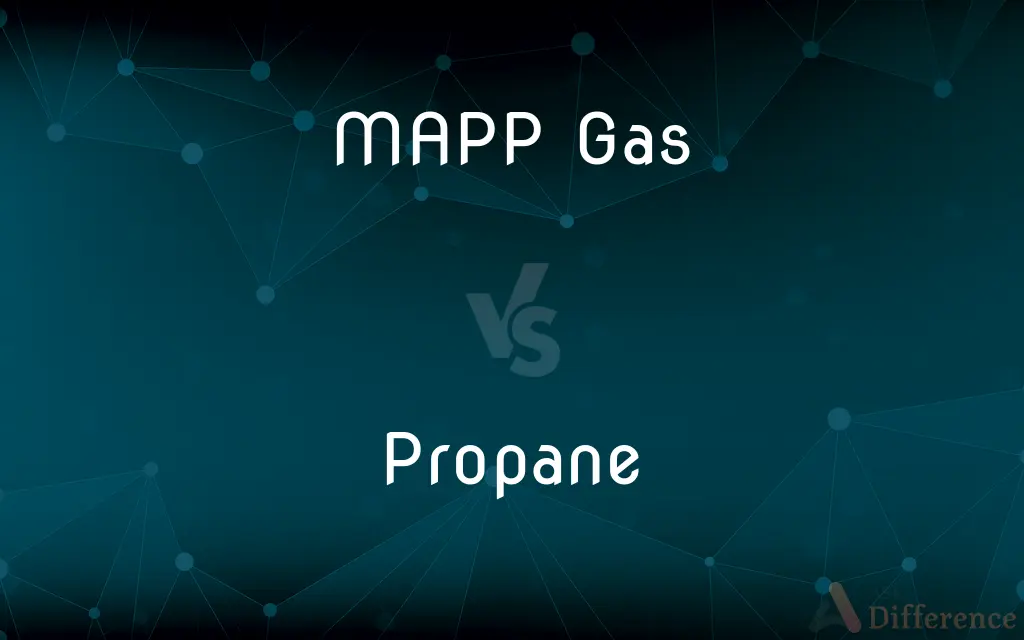MAPP Gas vs. Propane — What's the Difference?
By Maham Liaqat & Fiza Rafique — Published on February 25, 2024
MAPP gas burns hotter than propane, offering higher temperatures for tasks like welding and metal cutting. Propane, being less expensive and more readily available, is widely used for heating, cooking, and fueling vehicles.

Difference Between MAPP Gas and Propane
Table of Contents
ADVERTISEMENT
Key Differences
MAPP Gas and Propane are both flammable gases used as fuel for heating, cooking, and industrial applications, but they have distinct characteristics and uses based on their chemical properties and combustion temperatures.
MAPP Gas, a trademarked name for a liquefied petroleum gas mixed with methylacetylene-propadiene, was originally formulated to provide a higher temperature flame than propane. It is especially favored in industrial applications such as soldering, brazing, and cutting because of its ability to produce a hotter flame, reaching temperatures up to 2,020°C (3,668°F) in oxygen. This makes it particularly useful for tasks requiring high heat, such as metalworking. However, the original MAPP gas production was discontinued, and what is now often marketed as "MAPP" is actually MAPP substitute or propylene, which still offers higher temperatures than propane but not as high as the original MAPP gas formulation.
Propane, a byproduct of natural gas processing and petroleum refining, is known for its versatility and ease of storage and transport. It burns at a lower temperature than MAPP gas, with a maximum flame temperature of approximately 1,980°C (3,596°F) in oxygen, making it less suited for high-temperature industrial applications but ideal for home heating, cooking, and as fuel for certain engines. Propane's lower cost and wide availability have made it a popular choice for a variety of applications, from residential barbecues to industrial heaters.
Both gases are used in similar applications, while the choice between MAPP gas and propane often comes down to the specific requirements of the task at hand, including the needed flame temperature, cost considerations, and availability.
Comparison Chart
Flame Temperature
Up to 2,020°C (3,668°F) with oxygen
Up to 1,980°C (3,596°F) with oxygen
ADVERTISEMENT
Applications
High-temperature welding, cutting, brazing
Heating, cooking, fuel for vehicles
Cost
Generally more expensive
Less expensive
Availability
Less common than propane
Widely available
Burn Rate
Faster, providing higher heat quicker
Slower compared to MAPP gas
Suitability
Preferred for industrial applications requiring intense heat
Suited for residential and some industrial uses
Compare with Definitions
MAPP Gas
Generally more expensive due to higher heat output.
Professional plumbers may use MAPP gas despite its cost for efficient soldering.
Propane
A versatile fuel gas for heating and cooking.
Propane grills are popular for backyard barbecues.
MAPP Gas
Suitable for tasks requiring intense heat.
Jewelers utilize MAPP gas for its ability to quickly reach melting temperatures of metals.
Propane
More affordable and readily available.
Campers often choose propane for portable stoves due to its cost-effectiveness.
MAPP Gas
A high-temperature fuel gas used for metalworking.
MAPP gas torches are preferred for precision welding tasks.
Propane
Used across residential and commercial settings.
Restaurants employ propane for outdoor heating solutions.
MAPP Gas
Offers hotter flames than propane.
Metal artists use MAPP gas for faster brazing operations.
Propane
Powers vehicles and generators as a clean alternative to gasoline.
Some buses run on propane for a more environmentally friendly fuel option.
MAPP Gas
Less widely available but valued for specific applications.
Specialty workshops stock MAPP gas for high-temperature metal cutting.
Propane
Colorless gas found in natural gas and petroleum; used as a fuel
Propane
Burns at a lower temperature than MAPP gas.
Home handymen use propane torches for light soldering work.
Propane
A colorless gas, C3H8, found in natural gas and petroleum and widely used as a fuel.
Common Curiosities
Can I use a propane torch for applications recommended for MAPP gas?
A propane torch can be used for some applications, but it may not achieve the same results as MAPP gas for tasks requiring higher temperatures.
Can MAPP gas and propane be used interchangeably?
While they can be used with the same equipment for some applications, their different temperatures mean they're not always interchangeable, especially for tasks requiring specific heat levels.
Can either gas be used indoors?
Both can be used indoors with adequate ventilation, but it's essential to follow safety guidelines to prevent the accumulation of harmful fumes.
Is MAPP gas safer to use than propane?
Safety depends more on handling practices than the gas type. Both gases require proper ventilation and care to prevent accidents.
What should I do if I smell gas leaking?
If you smell a gas leak, shut off the valve (if safe to do), evacuate the area, and contact emergency services. Do not ignite any flames or electrical switches.
Where can I buy MAPP gas or propane?
Propane is widely available at hardware stores, gas stations, and home improvement centers. MAPP gas, or its substitutes, can be found at welding supply stores or specialty suppliers.
Are there environmental concerns associated with using MAPP gas or propane?
Both gases emit carbon dioxide when burned, but propane is considered a "green" fuel for its lower carbon footprint compared to other fossil fuels. Proper ventilation and minimal use can mitigate environmental impacts.
Why is MAPP gas more expensive than propane?
MAPP gas's higher cost is due to its higher combustion temperature and specialized applications, making it more expensive to produce and distribute.
How should I store MAPP gas or propane tanks?
Store in a cool, dry place away from direct sunlight, heat sources, and securely out of reach of children. Outdoor storage is recommended when possible.
How do I dispose of MAPP gas or propane canisters?
Both types of canisters should be completely emptied and taken to a hazardous waste disposal facility or recycling center that accepts hazardous materials.
Share Your Discovery

Previous Comparison
Dell Optiplex vs. HP Elitedesk
Next Comparison
Daycare vs. PreschoolAuthor Spotlight
Written by
Maham LiaqatCo-written by
Fiza RafiqueFiza Rafique is a skilled content writer at AskDifference.com, where she meticulously refines and enhances written pieces. Drawing from her vast editorial expertise, Fiza ensures clarity, accuracy, and precision in every article. Passionate about language, she continually seeks to elevate the quality of content for readers worldwide.
















































